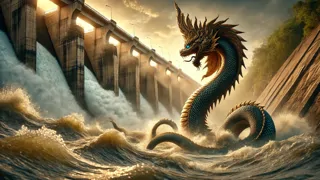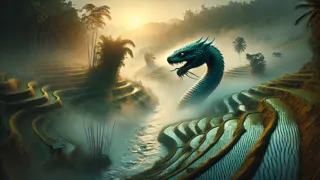Introduction
Nestled in the undulating plains of northeastern Thailand lies a labyrinth of jade-green rice terraces and winding waterways, where mist drifts between slender bamboo groves each dawn. Generations of farmers have coaxed golden harvests from the flooded paddies, honoring the Naga—ancient serpent spirits believed to guide the monsoon and guard the wetlands with gleaming scales beneath the currents. This harmony now trembles under the roar of heavy machinery, as engineers erect a concrete dam at the river's cusp, promising controlled irrigation for distant cities. Elsewhere, faint lantern light from riverside shrines flickers as families lay lotus petals and incense at carved cobra-head stones, a timeless gesture of respect to the waters. Rumors of ghostly silhouettes and glowing eyes beneath the water circulate among wary villagers, but many dismiss such tales as folklore. Then tremors begin to shudder through the levees, and swirling eddies overturn embankments, sending crystal waters cascading into standing fields like liquid gemstones. Villagers gather at the riverbank under a silvered moon, their breath caught between fear and reverence, waiting to see whether these signs foretell divine warning or ecological awakening. As dawn light gilds the horizon of palmetto palms, a soft rumble resonates from the depths—a pulse echoing the heartbeat of a myth reborn, setting the stage for a confrontation between ancient powers and modern ambition.
Awakening of the Naga
Long before any surveyor cleared the forest, the Mae Khong wetlands stretched like living tapestries across eastern Thailand, stitched together by hidden channels and sedge grass that whispered in the morning light. Farmers navigated these waterways in narrow wooden boats, trailing bamboo poles until they felt the gentle resistance of submerged ridges, and they believed that each ripple beneath them carried the echo of a serpent spirit’s breath. Local elders recounted how the first Naga awoke from a slumber of centuries, its sapphire scales shimmering beneath the currents, guiding monsoon floods toward thirsty paddies and then releasing the waters at just the right moment. These tales were etched into clay tablets in ancient temples, where cobra-headed columns bore witness to the bond between people and water. Foundations near the village shrine still held fragments of those carvings—coiled guardians gazing south, flanked by lotus blossoms. As the dry season crept in, thin tendrils of fog would curl around bamboo groves and the villagers lay offerings of jasmine petals and incense, hoping to beckon the Naga’s blessing before planting rice. That custom persisted even as distant cities demanded more water and engineers spoke of progress with measured confidence. In firelit meetings by the riverbank, the elders debated in hushed tones whether the spirit that had nurtured their fields might soon turn away if its ancient home was sacrificed for concrete walls. They watched each sunrise through anxious eyes, listening for the Naga’s reply in the clatter of kingfishers and the rumble of shifting sandbars. No one could say for certain if the great serpent observed them still, but every crack in their embankments, every sudden current, felt like a heartbeat trailing just beneath the lens of mortal ambition.

Tides of Conflict
Soon after the dam’s foundation was poured, the river began to churn in ways it never had before. Without warning, water levels fluctuated wildly downstream, leaving once-fertile terraces parched, then flooding them in turbulent sweeps that toppled bamboo markers and overturned granaries. Villagers who had revered the Naga for generations whispered that the great serpent was unleashing its fury, lashing out against cold stone that imprisoned its waters. Engineers blamed unstable sediment and monsoon surges, yet each time they patched leaks and reinforced gates, the river found a new breach—an underground fissure here, a collapsed buttress there. At night, those who ventured close to the dam reported ghostly shapes sliding across its concrete face, as if vast coils were testing the metal’s strength. Local farmers woke to entire fields submerged in swirling foam, the tips of their carefully transplanted rice shoots bobbing helplessly in the breach. In one harrowing incident, a narrow wooden walkway spanning a flooded canal collapsed without warning, sending two fishermen into a roiling current that withdrew just before they drowned, leaving them blinking on a sandy bar. They swore they saw a massive tail flick beneath the surface, stirring the water like a living wave. Panic welled in the village council hall as officials bickered over compensation and safety protocols, while families huddled in their huts, listening for the telltale hiss of scales sliding through the mud. Traditional priests performed urgent rites along both banks, sacrificing chickens and scattering grains of rice to appease the Naga’s wrath. Yet even these offerings felt fragile before the elemental force they believed had awakened to safeguard its realm. In hushed nighttime vigils, children dreamt of great amber eyes glowing just beneath the riverbank, and parents clutched their shawls, wondering if faith alone would be enough to hold back such an ancient tide of power.

Conclusion
Under a rose-tinged dawn, the village elders and engineers finally came together on a battered wooden pontoon erected midstream. As the sun climbed over distant rafters of palm trees, they spoke of compromise: a lowered crest on the dam to restore seasonal floods, carefully timed releases to mimic the old rhythms, and a sanctuary channel carved to give the Naga a permanent spiral refuge beneath the wetlands. In solemn ceremony, the community laid offerings of lotus and tamarind fruit at a simple stone plinth carved with a coiled head—an acknowledgment that progress must honor the spirit forces woven into the land. That morning, the river stilled in perfect balance, and for a moment its surface shone like polished onyx undisturbed. The farmers turned their oxen toward the newly seeded paddies, and distant laughter drifted through reed thickets. They knew the Naga watched still, its presence held in trust by human hands. In this ancient pact of water and earth, of serpent and soil, the rice fields promised bounty again. The dam remained, but it was reshaped—no longer an obstacle, but a companion in the endless dance between necessity and nature. And so the myth endured, written in every sunrise that glowed across those emerald terraces, a testament to the living bond between a people and their unseen guardians.

















